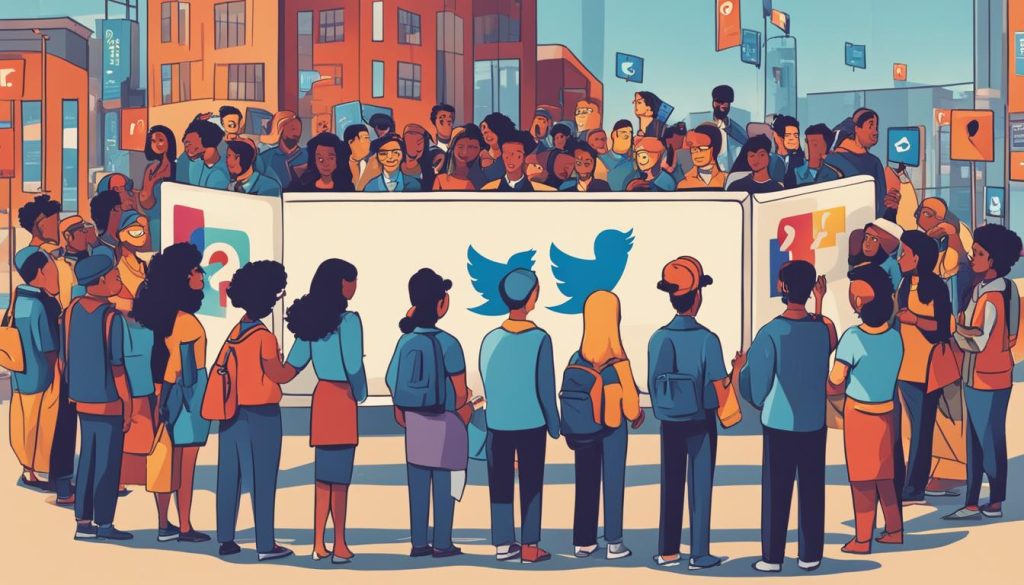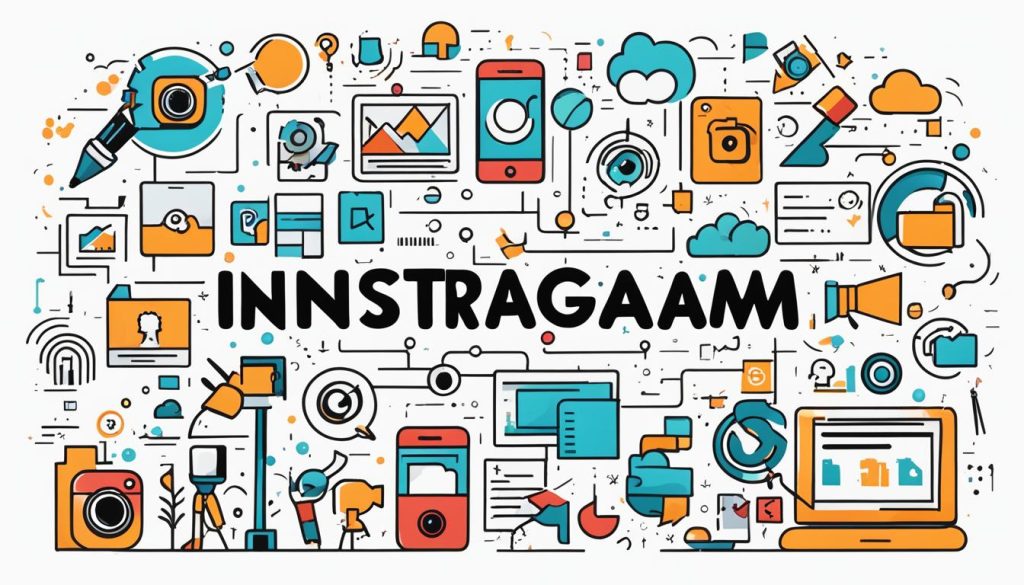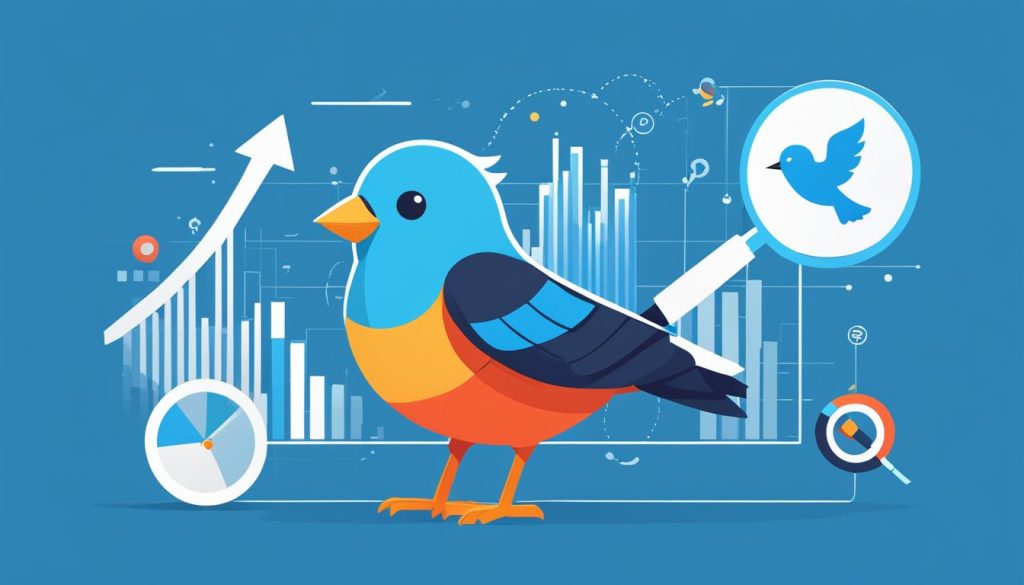As businesses vie to differentiate themselves in a bustling market, the importance of mapping out the customer journey cannot be overstated. Understanding every facet of the customer experience is not just an analytical exercise; it’s a requisite for enhancing engagement and accelerating conversions. Journey mapping allows you to visualise the multi-layered interactions that customers have with your company, presenting the opportunity to cultivate a customer-centric strategy that’s primed for long-term triumph.
Key Takeaways
- Customer journey mapping offers a visual guide to understanding customer interactions.
- Analysing the customer journey facilitates strategic improvements in customer engagement.
- Insights from journey maps are instrumental in personalising the customer experience.
- A customer-centric journey map is key to driving growth and fostering loyalty.
- Effectively designed journey maps can lead to increased conversions and competitive success.
Understanding the Essence of Customer Journey Mapping
Delving into the realm of customer journey mapping unlocks a treasure trove of insights that are integral to nurturing a customer-centric approach within any business. At its core, this strategic tool charts the course that customers navigate from the moment they become aware of a brand right through to the post-purchase phase. By understanding the importance and nuances of this mapping, your business can harness enhanced marketing strategies that lead to superior user engagement and innovation opportunities, while significantly improving customer retention.
Defining Customer Journey Mapping and Its Significance
Customer journey mapping is more than a mere diagram; it’s an in-depth visual story of your customer’s interactions with your brand. Central to this concept is the identification of key phases – awareness, consideration, purchase, and loyalty – each holding pivotal significance in the continuum of engagement. This roadmap not only helps elucidate the path to conversion but also provides actionable insight into refining the overall customer experience, forming the bedrock for a robust customer retention strategy.
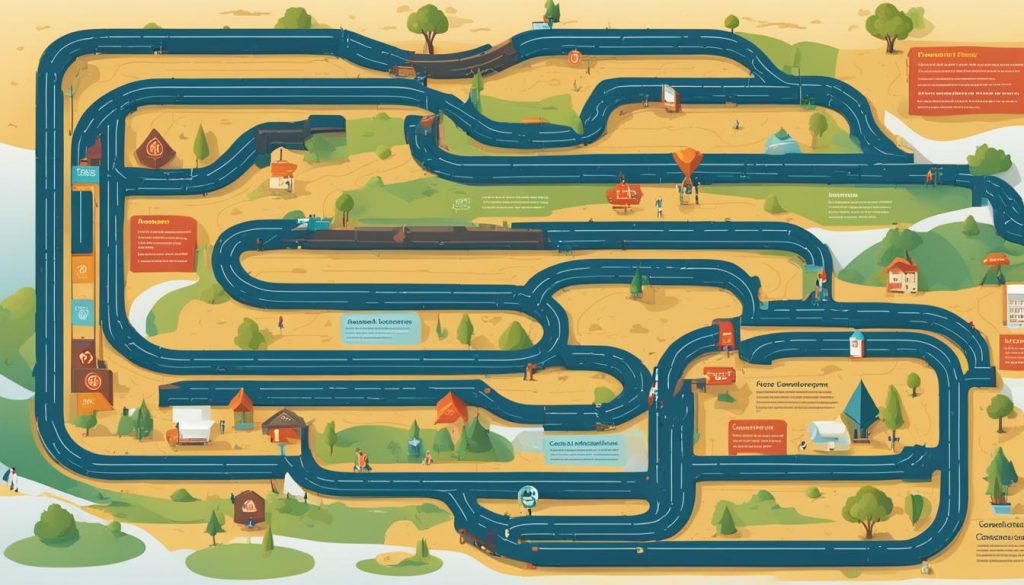
The Psychology Behind the Customer Experience
The psychological framework of customer journey mapping delves into the interplay between thoughts, emotions, and behaviours that customers exhibit when interacting with your brand. Unpacking the customer’s experience at each juncture can shed light on their decision-making processes, highlighting areas for potential emotional engagement and personalised communications. By placing an emphasis on these psychological insights, you open the door to deeper levels of customer engagement and satisfaction.
Aligning Your Business with the Customers’ Perspective
Adopting a customer’s viewpoint can revolutionise your business’s connection to its audience. This alignment encompasses understanding your customer’s desires, anticipating their needs, and addressing their concerns at every touchpoint. It’s through this lens that you can truly personalise and refine the customer journey, fortifying brand loyalty and leveraging every interaction as an opportunity for innovation and growth – hallmarks of a truly customer-centric organisation.
The Role of Touchpoints in Shaping the Customer Experience
As you delve into the nuances of the customer journey, it’s vital to recognise the impact of varying touchpoints — the times when customers come into contact with your brand throughout their purchasing process. These interactions can include moments spent navigating your website, exchanges on social media, customer service correspondence, and more. It is at these touchpoints where behavioural insights are most vividly captured, and the customer’s experience is profoundly shaped.
To optimise these critical interactions, you must understand the value of each touch point and utilise this knowledge for strategic enhancements. This could involve the implementation of a compelling call to action, to sway customer decisions, or the introduction of precise user testing, to refine the user experience continually.
Each customer touchpoint is an opportunity to influence the journey positively and guide the customer towards a favourable action.
Moreover, conversion tracking and analytics play pivotal roles in providing tangible evidence of how adjustments at these touchpoints drive success or identify areas needing improvement. Grounding your strategies in reliable data ensures that you’re not just guessing at what might work; you’re applying methods proven to enhance the customer journey.
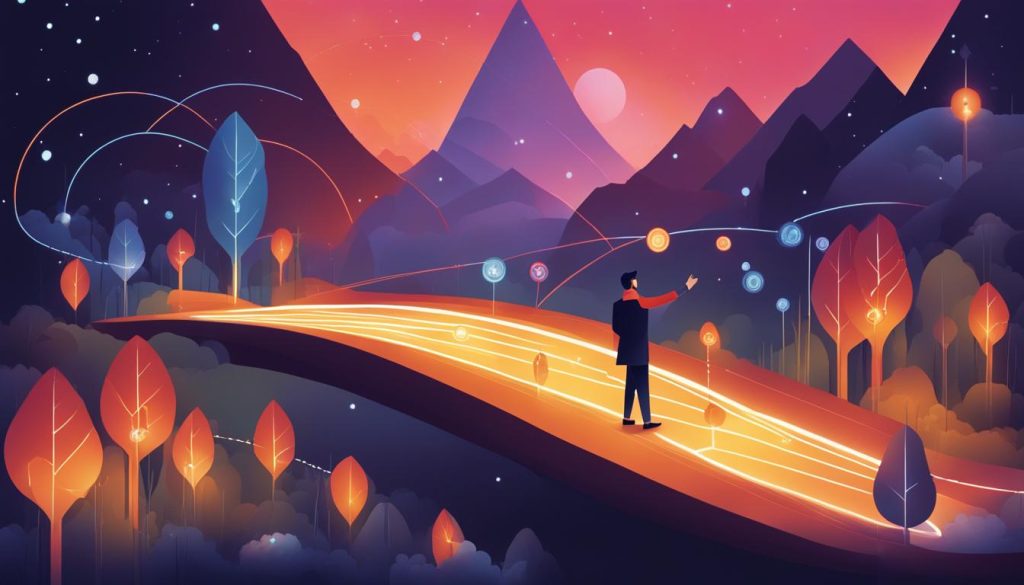
Here’s a simplified overview of how a business might track and optimise various customer touchpoints:
| Touchpoint | Behavioural Insight Gleaned | Optimisation Technique | Intended Outcome |
|---|---|---|---|
| Homepage Visit | User hesitancy at the call to action | A/B testing on CTA buttons | Increased click-through rates |
| Social Media Interaction | High engagement with how-to content | Develop more educational content | Better engagement and follower growth |
| Customer Service Call | Feedback on product difficulties | Product improvement & staff training | Reduced complaints, enhanced satisfaction |
| Email Communication | Low open rates for promotional emails | Personalised email campaigns | Improved open rates and conversions |
By meticulously scrutinising each touchpoint and applying targeted optimisation tactics, your business is poised to not only meet but exceed customer expectations, guiding them seamlessly from one stage of the journey to the next — with every step forward being a stride towards enhanced customer loyalty and increased conversions. Bear in mind that the landscape of customer interactions is constantly evolving, necessitating an agile approach in adapting to new behavioural trends.
Compiling a Blueprint: Strategies to Illustrate the Journey
When setting the foundations for an effective customer journey map, you must first identify and visualise the essential phases your customers encounter. This process allows you to hone in on the elements driving user engagement and nudges towards conversion funnels, providing a clearer view of how to structure landing pages and determine action triggers.
Identifying and Visualising Key Stages
To elucidate this crucial step, consider the customer’s journey not as a mere sequence of interactions, but as a narrative that unfolds through several pivotal chapters. Each stage – from awareness to consideration, and from decision to action – offers unique opportunities for copy variation and tailored messaging to guide users towards the desired outcome.
Tools and Resources to Craft Your Customer Journey Map
Employing reliable tools such as advanced CRM systems or dedicated mapping software is indispensable for capturing the complexity and dynamism of user behaviour. These tools not only streamline the visualisation of customer interactions but also enhance the precision in tracking and testing various components of your journey map.
Collecting and Analysing Data for Accurate Mapping
Your journey map’s accuracy pivots on the thorough gathering and subsequent analysis of data. Surveys, feedback forms, and cutting-edge analytics are vital in shedding light on customer sentiments at each touchpoint, ensuring that every aspect of the journey is meticulously calibrated and optimised to foster conversions.
Below is an example of how businesses might tabulate customer feedback to pinpoint areas for enhancement:
| Customer Stage | Feedback Category | Common Observations | Proposed Action |
|---|---|---|---|
| Discovery | Usability | Site navigation can be confusing to new visitors. | Refine site architecture and streamline navigation. |
| Consideration | Content | Product information lacks detail. | Enhance product descriptions and add customer reviews. |
| Purchase | Checkout Process | Checkout is too lengthy and complex. | Simplify checkout process and provide clear instructions. |
| Post-Purchase | Support | Customer service response is slow. | Improve response time and offer additional support channels. |
Building a journey map is indeed a multifaceted endeavour. Yet, by integrating the key components of conversion funnels with the real-world intricacies of landing pages and user behaviour, you can assemble a strategic framework that not only depicts user experiences but illuminates the route to commercial success.

Personalising the Path: Tailoring the Experience for Each Customer
As you delve into the intricacies of the customer journey, it’s imperative to embrace personalised marketing – a strategy that has become the cornerstone of successful enterprises. A staggering 91% of consumers are more likely to shop with brands that recognise their individual preferences and recommend options accordingly. Embarking on personalisation enhances crucial engagement metrics, user satisfaction, and cultivates loyalty, laying the groundwork for bolstered conversion rates and elevated revenue.
To truly individualise the journey, consider every element from microcopy to button text–each a pivotal piece in the puzzle of personalisation. Incorporating a customer’s name, calibrating content, and adjusting product recommendations based on behavioural data are quintessential moves that turn a generic encounter into an individualised narrative, resonating deeply with your clientele.
Moreover, invoking a sense of urgency creation can significantly impact purchasing decisions. By employing tactics, such as time-sensitive offers and compelling call-to-actions (CTA), you can spur customers into action whilst maintaining a personalised touch that’s tantamount to the shopping experience.
- The need for urgency in messaging and offers
- Tailoring CTAs for maximised click-through rates
- Enhancing user experience through personalised content
- Measuring the impact of personalisation on engagement metrics
| Personalisation Element | Benefit | Examples |
|---|---|---|
| Microcopy | Increases relevance and connection | “Hello [Name], we’ve got just the thing for you!” |
| Button Text | Encourages targeted actions | “Buy now and save 10% on your first order!” |
| Urgency Creation | Drives immediate responses | “Limited offer ends in 1 hour!” |
| Personalised Offers | Boosts sales through tailored deals | “Exclusive discount on your favorite items!” |
Remember, the journey doesn’t end at the checkout. Post-purchase communication is as vital as the first hello. Keep engaging with your customers by seeking feedback and providing personalised aftercare. This continuous loop of interaction is what sets distinguished brands apart and keeps customers returning.
So, are you ready to give your customers an unprecedented journey that truly feels like it’s crafted just for them? By focusing on a personalised path, you’re not just selling a product or a service; you’re providing an experience that’s uniquely theirs. Start personalising and watch your brand relevance, and consumer bond, soar to new heights.
Mapping Out the Customer Journey with Grew Studio
Embark on a strategic journey mapping experience at Grew Studio, where your business needs are met with a personalised touch and savvy marketing insight. Let’s explore how we meticulously sculpt the pathway to your customer’s loyalty and conversion.
Our Approach to Crafting Customised Journey Maps
At Grew Studio, we believe each brand has a unique story that can only be told by understanding its audience down to the finest detail. This is why we pride ourselves on offering strategic business consultation that goes beyond the surface to create tailor-made journey maps for each distinct customer segment. With your goals as our blueprint, we chart the course of your customers’ experience through a strategic lens to guarantee a pathway that not only speaks to the heart of your audience but also drives measurable results.
The Role of Adam Oliver Kollar in Refining Customer Paths
CEO Adam Oliver Kollar sets the compass for Grew Studio’s customer journey mapping direction. His expertise in strategizing and perfecting the nuances of user interaction ensures that your personalised journey map encapsulates the essence of user engagement. As a champion for meticulous CTA design and landing page optimisation, Kollar’s insights filter into strategies that resonate well with your intended market, creating a seamless path from discovery to action.
Leveraging Expert Consultation for Enhanced Journey Mapping
Every turn of your customer’s journey deserves special attention. Through our expertise in landing page optimisation and compelling CTA design, we ensure that every digital footstep made by your audience is optimally positioned for conversion. Grew Studio’s approach not only aligns with pioneering marketing strategy, but infuses every map with a forward-thinking, results-oriented philosophy.
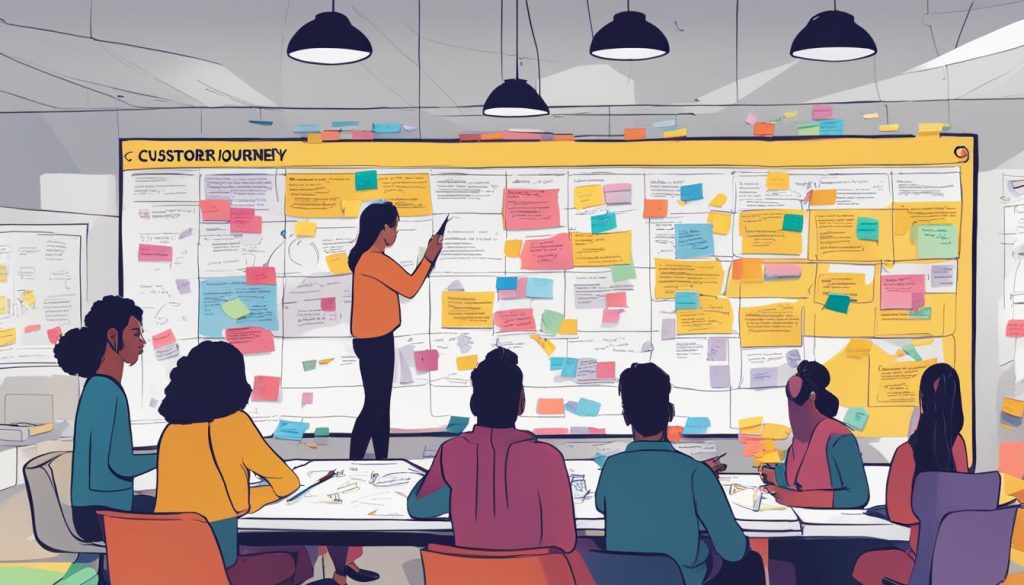
Analysing the Roadmap: Interpreting Journey Maps to Optimise Business Outcomes
When you delve into your customer journey maps, it’s not just about skimming through a chart of touchpoints. It’s about peering through them with a magnifier, considering your overarching business objectives. It’s about answering crucial inquiries: Where do your customers find joy, and where do they stumble? It’s these insights that enable you to optimise interaction design, experiment with CTA placement, and leverage colour psychology to enhance the user experience.
Interaction design is your wand for crafting engaging digital environments where each element lives to enhance the user’s interaction. Meanwhile, pinpointing the exact location for your Call to Action (CTA) placement is both an art and a science, influencing user navigation and decision-making. Through multivariate testing, refine and determine the most effective elements for your CTAs. Finally, understanding colour psychology can be the subtle difference that influences user mood and behaviour, a critical layer to the overall user experience.

By interpreting journey maps, businesses can identify stages requiring enhancements, where customers are feeling pleased or frustrated, and thus, how each step contributes to user experience.
Below is a comparison table that illustrates the potential outcomes of optimising various aspects of a journey map.
| Aspect | Before Optimisation | After Optimisation |
|---|---|---|
| Interaction Design | Basic functionality | Intuitive and seamless user interface |
| CTA Placement | Standard positioning | Strategic placement based on user behaviour analysis |
| Multivariate Testing | Single variant testing | Comprehensive analysis leading to data-backed decisions |
| Colour Psychology | Generic colour scheme | Colour scheme optimised for emotional resonance |
As you pivot towards these targeted improvements, guided by the data and analysis from your journey maps, you’re paving the way towards not just a more aesthetic or functional business model, but one that’s intricately connected to your clients’ psychological journey — aligning your business more closely with customer expectations and experiences.
The Impact of Technological Tools on Smoothening the Customer Journey
In the rapidly evolving landscape of digital commerce, a seamless customer journey is paramount for fostering loyalty and ensuring customer satisfaction. The utilisation of technological advancements is central to achieving this. With the right tools, you can gain deeper insights into customer preferences, streamline their interactions, and personalise experiences with predictive precision. This revolution in understanding and engaging with customers is transforming businesses, enabling them to meet the high standards of today’s digital-first consumers.
Implementing CRM Systems for Intelligent Insights
Customer Relationship Management (CRM) systems are the backbone of customer data management. These powerful platforms integrate various sources of customer information, offering a unified view that can lead to enriched customer interactions. By taking advantage of advanced CRM capabilities, your business is equipped to conduct intricate analyses, resulting in a refined understanding of customer needs and opportunities for cross-selling and upselling. This intelligence not only enhances the customer experience but also drives strategic decision-making.
Automating Interactions: Chatbots, Email Marketing and More
Automation tools such as chatbots and sophisticated email marketing workflows offer efficiency and consistency in customer interactions. Chatbots handle inquiries instantaneously and maintain a level of personalisation previously attainable only through human interaction. Similarly, automated email campaigns can nurture leads, provide valuable content, and maintain engagement with minimal human oversight. These tools ensure timely and relevant communication, fostering a journey that feels both personal and frictionless.
Using Analytics to Predict and Adapt to Customer Behaviour
Leveraging analytics is critical in deciphering patterns and predicting future customer behaviour. With predictive analytics, you can anticipate customer needs, tailor your marketing efforts more precisely, and offer proactive solutions before they even arise. This forward-thinking approach aligns products and services with customer expectations, significantly improving the overall customer journey and ensuring your brand remains a step ahead in a competitive market.
Each of these technological advancements contributes to a customer journey that is not only streamlined but also highly responsive to individual consumer needs. In your quest to provide a seamless experience, embrace CRM systems, automation tools, and analytics as instruments that will enable you to predict and adapt to the consumer’s journey—keeping you agile in a market that never stands still.
Revolutionizing Conversion: How Effective Journey Maps Lead to Business Growth
Understanding the nuances of customer interactions is pivotal in enhancing your conversion rates and expanding your business. Journey maps are not just illustrative diagrams but tools that lay bare the complex web of customer experiences, guiding you towards actionable insights for growth.
Improving Engagement Metrics and Click-Through Rates
Imagine a scenario where every customer feels heard and understood; that’s the height of personalisation you can achieve with effective journey mapping. By pinpointing the touchpoints that truly matter, you can tailor your messaging, thereby significantly uplifting your engagement metrics and click-through rates.
It’s about crafting that perfect call-to-action, the one that resonates and prompts an immediate response. Your efforts in enhancing user experience can be seen in the data—more clicks, more engagement, more success.
Spotlight on Conversion Optimisation and Sales Boosting Techniques
Fine-tuning the intricacies of your customer’s journey can lead to a direct surge in sales. Conversion optimisation is not guesswork; it’s a strategic move. With data-backed decisions gleaned from journey maps, you apply A/B testing to various elements, whether it’s your email campaign’s subject line or the colour of your ‘Buy Now’ button.
Assessing the Performance of CTAs through Mapping
Are your CTAs hitting the mark? Journey maps can be revelatory, showing you which calls to action are converting and which ones are languishing. Through careful assessment of CTA performance, you adjust and adapt, continually honing your strategy to align closer to your overarching conversion goals.
| Element | Baseline Conversion Rate | Post-Optimisation Conversion Rate | Improvement |
|---|---|---|---|
| Email Sign-Up CTA | 2.5% | 4.1% | +64% |
| Product Page ‘Add to Cart’ | 6.2% | 8.7% | +40% |
| Checkout Page Upsell | 1.9% | 3.3% | +74% |
Using this methodical approach, you’ll see a measurable upswing in campaign performance, with each change substantiated by the data derived from your journey maps. By zeroing in on results, you remain agile, adapting your techniques towards an enhanced conversion strategy that not only reflects but drives your business growth.
Conclusion
In conclusion, the journey towards comprehensive customer understanding is not a static one. The navigation of customer journey evolution demands your persistent attention and adaptability to harness the power of change, ensuring strategic business improvements are not just reactions but proactive steps towards a better alignment with customer behaviour and expectations. Adapting to this ever-evolving landscape is key to future-proofing your company, and it is by embracing change that you can draw the map to success.
Embracing the Continuous Evolution of Customer Journeys
As the market morphs and customer preferences shift, sticking to a rigid path can lead to obsolescence. Your willingness to embrace the continuous evolution of customer journeys will position your business as a dynamic entity, capable of meeting challenges head-on. By understanding that each interaction is an opportunity for continuous improvement, you are setting the stage for progress that resonates with the audience you serve.
The Ongoing Cycle of Mapping, Analysis, and Enhancement
Committing to the ongoing cycle of mapping, analysis, and enhancement ensures that your strategies are always up-to-date and effective. Consistent monitoring and refinement of customer journey maps yield a treasure trove of insights, helping you to anticipate shifts in consumer behaviour and stay ahead of the curve. Through this meticulous process, you can pinpoint where to deploy resources for maximal impact and efficiency.
Securing Your Company’s Future with a Customer-Centric Approach
A future-oriented company recognises the indispensable value of customer centricity in its organisational genetic code. By positioning your customers at the heart of your operations and decision-making, you are not only aligning with their needs but also fostering loyalty and trust. This trust is the currency of tomorrow’s business landscape, enabling you to carve out longevity and success for your company amid the bustling market of today and the uncertain one of tomorrow.
FAQ
What is customer journey mapping and why is it important?
Customer journey mapping is the process of creating a visual representation of a customer’s experience with a brand across all touchpoints. It’s important as it helps businesses understand and enhance the customer’s experience, leading to improved customer engagement and conversions.
How does customer psychology factor into the customer experience?
Customer psychology plays a crucial role in the customer experience as it helps businesses grasp how customers feel and what they think during their interactions. It provides insights into customer behaviour which can be used to align business strategies with customer needs.
How can touchpoints be used to shape the customer experience?
Touchpoints are various interactions customers have with a brand and they can be strategically improved using behavioural insights, CTA design, and other engagement techniques to enhance the overall customer experience and help guide the customer through the conversion funnel more effectively.
What are some effective strategies for creating a customer journey map?
Effective strategies for creating a customer journey map include identifying and visualising the key stages of the customer experience, utilising CRM and journey mapping software, and gathering data through analytics to understand user behaviour and action triggers.
Why is personalisation critical in the customer journey?
Personalisation is critical because it makes the customer feel recognised and valued, which can lead to increased engagement, brand loyalty, and optimised conversion rates. Personalised experiences are often more resonant and memorable, leading to a stronger customer-brand connection.
How does Grew Studio approach customer journey mapping?
Grew Studio takes a collaborative approach, combining industry expertise with a personalised touch to craft custom journey maps that reflect each client’s unique customer segments. They focus on conversion optimisation and strategic business consultation to enhance the customer journey.
Why is journey map analysis essential for business outcomes?
Analysing journey maps is essential because it allows a business to determine which parts of the customer journey are working well and which need improvement. It helps optimise user experience through targeted strategies, such as refining CTA placement and interaction design.
How do CRM systems improve the customer journey?
CRM systems improve the customer journey by centralising customer data, which allows for more intelligent and personalised communications. They also provide analytical insights that guide businesses in adapting their strategy to meet customer needs effectively.
How does effective journey mapping drive business growth?
Effective journey mapping can lead to better engagement metrics and click-through rates, help in fine-tuning conversion optimisation strategies, and provide insights into CTA performance. This culminates in a more effective conversion funnel and increased business growth.
What is the importance of continuous improvement in customer journey mapping?
Continuous improvement is essential because customer behaviour and expectations evolve over time. Regular mapping and analysis enable a business to adapt its strategies dynamically, ensuring the customer experience remains relevant and satisfying.

